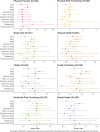Health-related quality of life after surviving intensive care for COVID-19: a prospective multicenter cohort study
- PMID: 37865685
- PMCID: PMC10590404
- DOI: 10.1038/s41598-023-45346-2
Health-related quality of life after surviving intensive care for COVID-19: a prospective multicenter cohort study
Abstract
In survivors of severe coronavirus disease 2019 (COVID-19) incomplete mental and physical recovery may considerably impact daily activities and health-related quality of life (HRQoL). HRQoL can be evaluated with the RAND-36 questionnaire, a multidimensional instrument that assesses physical and mental aspects of health in eight dimensions. The objective was to investigate HRQoL in intensive care patients previously treated for COVID-19 at three Nordic university hospitals, in a prospective multi-center cohort study. HRQoL was measured using RAND-36, 3-9 months after discharge from intensive care units (ICU). One hospital performed a second follow-up 12 months after discharge. A score under the lower limit of the 95% confidence interval in the reference cohorts was considered as significantly reduced HRQoL. We screened 542 and included 252 patients. There was more than twice as many male (174) as female (78) patients and the median age was 61 (interquartile range, IQR 52-69) years. Hypertension was the most common comorbidity observed in 132 (52%) patients and 121 (48%) patients were mechanically ventilated for a median of 8 (IQR 4-14) days. In RAND-36 physical functioning, physical role functioning, general health (p < 0.001 for all) and social functioning (p < 0.05) were below reference, whereas bodily pain, emotional role functioning and mental health were not. In a time-to-event analysis female sex was associated with a decreased chance of reaching the reference HRQoL in the physical function, bodily pain and mental health dimensions. Higher body mass index was found in the physical functioning dimension and hypertension in the physical functioning, vitality and social functioning dimensions. Similar results were seen for diabetes mellitus in general health, vitality and mental health dimensions, as well as pulmonary illness in the physical role functioning dimension and psychiatric diagnosis in the social functioning dimension. Mechanical ventilation was associated with a decreased likelihood of achieving reference HRQoL in the bodily pain and physical functioning dimensions. Patients treated in an ICU because of COVID-19 had lower HRQoL 3-9 months after ICU discharge than 95% of the general population. Physical dimensions were more severely affected than mental dimensions. Female sex and several comorbidities were associated with a slower rate of recovery.Study registration: clinicaltrials.gov: NCT04316884 registered on the 13th of March 2020, NCT04474249 registered on the 29th of June 2020 and NCT04864938 registered on the 4th of April 2021.
© 2023. Springer Nature Limited.
Conflict of interest statement
The authors declare no competing interests.
Figures



References
-
- COVID-19 Map. Johns Hopkins Coronavirus Resource Centerhttps://coronavirus.jhu.edu/map.html
Publication types
MeSH terms
Associated data
LinkOut - more resources
Full Text Sources
Medical
Miscellaneous

